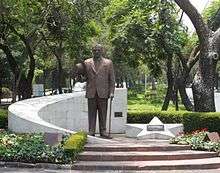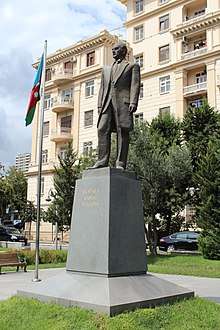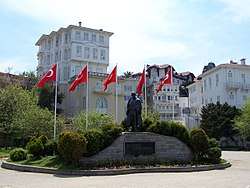Atatürk's cult of personality
Atatürk's cult of personality was started by Mustafa Kemal Atatürk's successors after his death in 1938, by members of both his Republican People's Party and opposition parties alike,[1] and in a limited amount by himself during his lifetime in order to popularize and cement his social and political reforms as a founder and the first President of Turkey.[2] It has been described as the "world's longest-running personality cult".[3]


| ||
|---|---|---|
|
Family and relatives
|
||
Overview
Following the defeat and partitioning of the Ottoman Empire by the Allies in the aftermath of World War I, Mustafa Kemal led his country through a War of Independence against Greece, Armenia, France, Britain, and other invading countries. Under his leadership, the Republic of Turkey was declared in 1923, and he was honoured with the name Atatürk ("Father of the Turks") by the Grand National Assembly of Turkey in 1934. His other titles include Great Leader (Ulu Önder), Eternal Commander (Ebedî Başkomutan), Head Teacher (Başöğretmen), and Eternal Chief (Ebedî Şef).[4][5]
Atatürk's memory remains a major part of Turkish politics and society into the 21st century.[6] Almost every city in Turkey has streets named for him, and statues of him are commonly found in city squares, schools, and public offices, the latter two of which feature his portrait. The phrase Ne mutlu Türküm diyene (How happy is the one who says "I am a Turk"), which Atatürk used in his speech delivered for the 10th Anniversary of the Republic in 1933, is used widely in Turkey and is often seen along with his statues.
Atatürk's cult of personality is sometimes compared to those of authoritarian rulers of Central Asian countries, such as Nursultan Nazarbayev and Saparmurat Niyazov,[7] but differs significantly in light of Atatürk's democratic and progressive reforms in Turkey and because most of the statues and memorials of him were erected after his death. For example, before the 1950s, only the incumbent President of Turkey's image appeared on Turkish currency, but Prime Minister Adnan Menderes (1950–1960), in a political blow to rival President İsmet İnönü, passed a law to restore the late Atatürk's image on the currency in order to deny İnönü's image appearing instead.[1] Menderes's government, although opposed to Atatürk's Republican People's Party (which served as the opposition party in Parliament to Menderes's Democrat Party government), continued to utilize Atatürk's popularity among the Turkish citizenry by moving his body to a "grandiose" mausoleum 15 years after his death in 1953.[1] It also passed a law in 1951 that criminalized insulting "Atatürk's memory."[1]
The Economist wrote in 2012 that his personality cult "carpets the country with busts and portraits of the great man" and that this has been "nurtured by Turkey's generals, who have used his name to topple four governments, hang a prime minister and attack enemies of the republic."[8] According to this British weekly, "hard-core Islamists despise Ataturk for abolishing the caliphate in 1924 and expunging piety from the public space. They feed rumours that he was a womaniser, a drunk, even a crypto-Jew."[8]
A 2008 article in National Identities also discussed Atatürk's ubiquitous presence in the country:
Atatürk's houses exist in an Atatürk-inundated context with his face and sayings appearing on all official documents, buildings, television channels, newspapers and schoolyards, coins and banknotes. Moreover, regardless of personal belief, every Turk lives in a country where nationalism is part of standard political discourses. Politicians, teachers and journalists appeal to the nation and Atatürk on a daily basis. Yet they are not alone in this. The omnipresence of Atatürk paraphernalia can only be partly attributed to state sponsorship. Atatürk’s face appears on posters behind supermarket counters, in barbershops and video stores, in bookshops and banks; Atatürk talismans even dangle from car mirrors, while Atatürk pins adorn lapels. And even the Turks who do not join in with such spontaneous commemorations know how to 'read' the Atatürk semiotic universe.[9]
Law on Atatürk
Turkish Law 5816 ("The Law Concerning Crimes Committed Against Atatürk")[10] was passed 13 years after Atatürk's death on July 25, 1951 by Prime Minister Adnan Menderes's government,[11] and protects "Atatürk's memory" from being offended by any Turkish citizen.[12] In 2011, there were 48 convictions for "insulting Atatürk"[8] and insulting Atatürk's memory is punishable by up to three years in jail.[13]
YouTube block
In March 2007, after numerous videos insulting Atatürk were discovered on YouTube, a Turkish high court had YouTube blocked in the country.[14] The following text was written on the page: "Access to this site has been blocked by a court decision! Access to YouTube.com site has been suspended in accordance with decision no: 2007/384 dated 06.03.2007 of Istanbul First Criminal Peace Court."[15] Kursat Kayral, the Public Prosecutor of Turkey, requested from the US government the identities of YouTube users who insult Atatürk, Turkey and the country's flag in order to investigate them for possible prosecution.[16] The YouTube ban was lifted in November 2010.[17]
List of places named after Atatürk
Numerous places in Turkey have been named after Atatürk, the nation's founding father. According to a Lonely Planet guide to Turkey: "His name is affixed to bridges, airports and highways too many to mention. And seemingly every house where he spent a night from southern Aegean to the Black Sea is now a museum."[18]
Places named after Atatürk include:
Statues
The first statue of Atatürk was sculpted in 1926 in the Sarayburnu district of Istanbul by Austrian sculptor Heinrich Krippel.[19] Today, statues of Atatürk can be found all over Turkey.[20][21]
In Turkey
Ankara
.jpg) Marshal Atatürk Monument, Ulus in 1927
Marshal Atatürk Monument, Ulus in 1927 Same statue in 2008
Same statue in 2008- Ankara
 Ankara
Ankara- Ankara
Istanbul
- Republic Monument, Istanbul
 Istanbul
Istanbul İstanbul Sirkeci Terminal
İstanbul Sirkeci Terminal
- Istanbul University campus

Outside Turkey
- Budapest, Hungary[22]
- In March 2015 the city council of Carson, California unanimously voted against the erection of a sculpture of Atatürk.[23][24][25]
- Kemal Atatürk Memorial, Canberra, Australia
 Bucharest, Romania
Bucharest, Romania Tulça, Romania
Tulça, Romania Baruta, Venezuela
Baruta, Venezuela Mexico City, Mexico
Mexico City, Mexico.jpg)

 Baku, Azerbaijan
Baku, Azerbaijan.jpg) Nur-Sultan, Kazakhstan
Nur-Sultan, Kazakhstan.jpg) Dipkarpaz, Northern Cyprus
Dipkarpaz, Northern Cyprus_-_Turkish_Republic_of_Northern_Cyprus.jpg) Girne, Northern Cyprus
Girne, Northern Cyprus Manastır, North Macedonia
Manastır, North Macedonia
See also
References
- Notes
- Andrew Mango (26 August 2002). Ataturk: The Biography of the founder of Modern Turkey. Overlook. p. 36. ISBN 978-1-59020-924-0.
In 1937, Bayar had sought to outdo İnönü in his adulation of Atatürk. Now the Democrat Party government outdid him in signs of respect for Atatürk's memory. His body was transferred to a grandiose mausoleum in 1953. A law was passed in 1951 making it a criminal offence to insult Atatürk's memory.
- Tezcür, Güneş Murat (2010). Muslim Reformers in Iran and Turkey: The Paradox of Moderation. University of Texas Press. p. 70. ISBN 9780292773639.
A man who was either irreligious or did not wear his faith on his sleeve, Atatürk established a cult of personality that has survived until now. He did not bother to attend the Friday prayers, a symbol of ruler-people unity...
- Alexander Christie-Miller (April 20, 2013). "Lookalike keeps alive the cult of Ataturk". The Times of London.
- Levine, Lynn A. (2010). Frommer's Turkey. Hoboken, NJ: Wiley Pub. p. 31. ISBN 9780470877739.
Mustafa Kemal was given the name Atatürk ("father of the Turks") by the Grand National Assembly
- Villar, Juan (2004). The Seventh Wonder. Coral Springs, FL: Llumina Press. p. 28. ISBN 9781595262417.
The Turkish parliament proclaimed Mustafa's last name to be Ataturk, "Father of the Turks." Today, his picture hangs in every government office and business establishment, his state appears in every city, and his statues forbid that anything bad or ridiculous be said about him. Free Speech was not among Ataturk's reforms.
- Foreign Press on Cyprus, Volumes 10-11, Public Information Office, 1997 "It is the army's self-appointed role to maintain the secular character of a state that is 90 percent Muslim, but whose modern founder Kemal Ataturk forcibly wrenched into Westernization. The Ataturk cult of personality still towers over Turkey"
- Allison, Roy (1996). Challenges for the former Soviet south. Washington, D.C.: Brookings Institution Press. p. 27. ISBN 9780815703211.
A state-promoted "cult of personality" is developing rapidly in some of the Central Asian republics (although here, as in other ... This was clearly modeled on Mustafa Kemal Ataturk, the authoritarian modernizing leader of republican Turkey.
- "A secularist's lament". The Economist. 25 February 2012. Retrieved 17 March 2013.
- Glyptis 2008, p. 356.
- Bali, Rıfat N. (2007). New documents on Atatürk: Atatürk as viewed through the eyes of American diplomats. Isis Press. p. 32.
- Seibert, Thomas (16 August 2011). "Some Turks ready to abolish law that protects memory of Ataturk". The National. Retrieved 13 July 2013.
- Kaya, Mehmed S. (2009). The Zaza Kurds of Turkey: A Middle Eastern Minority in a Globalised Society. London: Tauris Academic Studies. p. 209. ISBN 9781845118754.
- Finkel, Andrew (2012). Turkey: What Everyone Needs to Know. New York: Oxford University Press. p. 32. ISBN 9780199733040.
- "Turkish court bans YouTube access". BBC News. 7 March 2007. Retrieved 13 July 2013.
- "Turkey pulls plug on YouTube over Ataturk 'insults'". Guardian. 7 March 2007. Retrieved 21 March 2013.
- "Turkey seeks names of YouTube's Ataturk insulters from U.S. gov't". Hürriyet Daily News. 2008. Retrieved 13 July 2013.
- "Turkey lifts YouTube ban". CNN. 1 November 2010. Retrieved 13 July 2013.
- Bainbridge, James (2009). Turkey (11th ed.). Footscray, Victoria: Lonely Planet. p. 40. ISBN 9781742203867.
- EĞRİKAVUK, IŞIL (9 January 2011). "Unaesthetic Atatürk monuments remain taboo in Turkey". Hurriyet. Retrieved 21 March 2013.
- Navaro-Yashin, Yael (2002). Faces of the State: Secularism and Public Life in Turkey. Princeton: Princeton Univ. Press. p. 89. ISBN 9780691088457.
Today the statue that is most frequently encountered all over Turkey is still that of Ataturk.
- Üngör, Ugur Ümit (2011). The Making of Modern Turkey:Nation and State in Eastern Anatolia, 1913-1950. Oxford University Press. p. 180. ISBN 9780191640766.
Mustafa Kemal Atatürk was the central focus of public manifestations of memory. Sculptures of him spread across the country in a matter of years and well before his death adorned every main square in the country.
- "Atatürk bust erected in Budapest, immediately vandalized". ALL HUNGARY NEWS. 8 October 2012. Archived from the original on 4 March 2016. Retrieved 17 March 2013.
- Suter, Leanne. "Carson City Council nixes controversial sculpture of Turkey president". abc7.com. WJLA-TV.
- "Atatürk memorial proposal rejected in Los Angeles". cihan.com.tr. Cihan News Agency. 6 March 2015. Archived from the original on 2015-03-09.
- "Carson City Council Unanimously Rejects Ataturk Monument Measure". Asbarez. 4 March 2015.
- Bibliography
- Copeaux, Etienne, ″La transcendance d’Atatürk″, in Mayeur-Jaouen Catherine (ed.), Saints et héros du Moyen-Orient contemporain, Paris, Maisonneuve et Larose, 2002, pp. 121-138.
- Glyptis, Leda (December 2008). "Living up to the father: The national identity prescriptions of remembering Atatürk; his homes, his grave, his temple". National Identities. London. 10 (4): 353–372. doi:10.1080/14608940802271647. ISSN 1460-8944.CS1 maint: ref=harv (link)
- Mandel, Mike, and Zakari, Chantal, The State of Ata. The Contested Imagery of Power in Turkey, Eighteen Publications, Boston, 2010, 256-xvi p.






.jpg)








.jpg)









